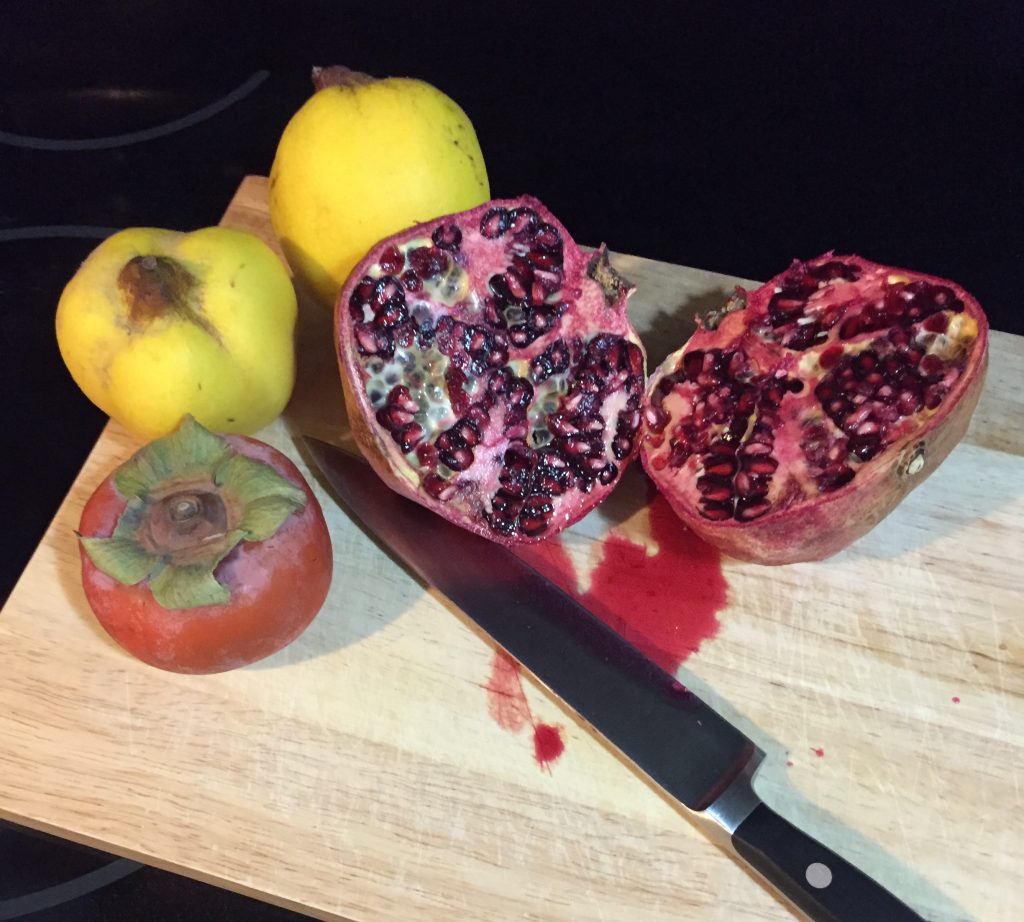
One of the great joys of making your own meals comes from discovering new ingredients. There’s a certain pride in knowing what you’re looking at as you walk through the grocery store, and in knowing what you can do with what you find. To that end, I’ve decided to begin profiling some of the more daunting offerings that you might find whilst shopping. My goal is to provide an introduction to the ingredients rather than a sampling of recipes. You can find plenty of recipes for any of these items online, but I’ve found that a recipe intimidates me when I’m working with something unfamiliar. I want to know the basics of how to prepare an ingredient and what it should taste like before I try to use it in conjunction with other items. To that end, I’ve begun by profiling three unusual fruits that hit our stores around this time of year: pomegranate, persimmon, and quince. What you’ll find here is an introduction to each fruit that should allow you to buy one (just one!), prepare it, and eat it by itself. If you like what you taste, you can branch out into full-blown recipes.
Pomegranate
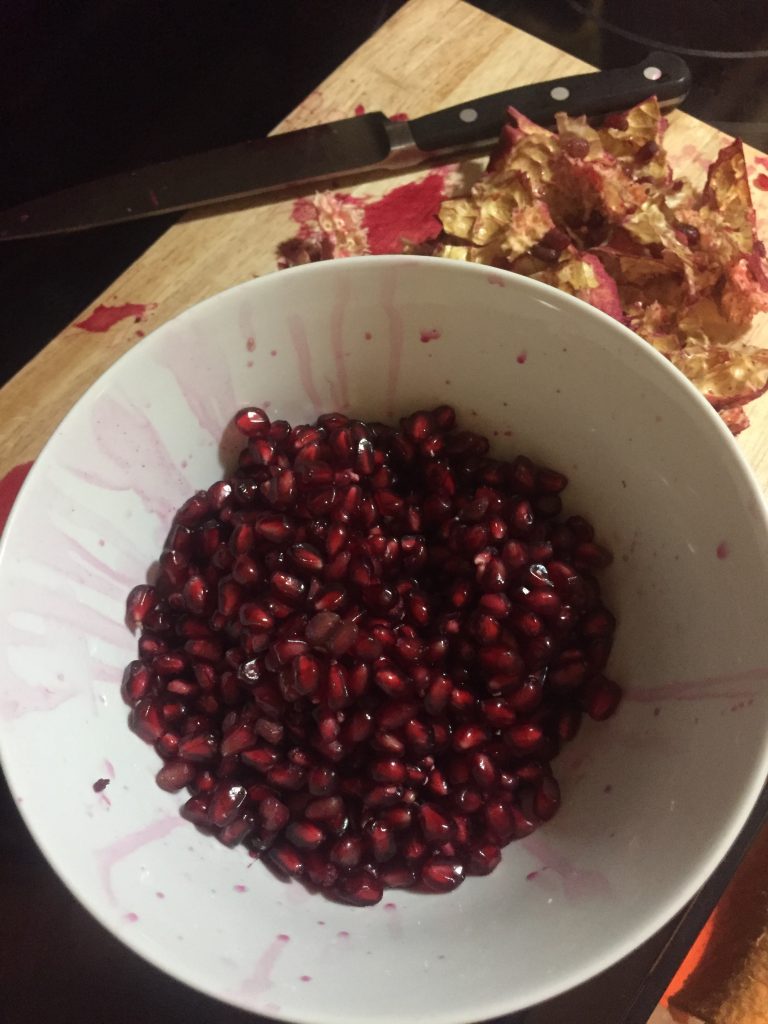
Apparently there has been speculation that the pomegranate may have been the fruit in the story of the Garden of Eden. If this is true, all I can conclude is that the eating of this fruit required a very deliberate effort. You don’t eat a pomegranate by mistake. You work for it, preferably while wearing dark clothing or an apron. I first attempted this task during graduate school, accompanied by my youngest sister. We tried eating the pomegranate with vanilla ice cream and were sorely disappointed. I’ve since found a number of better uses for pomegranate seeds and would recommend giving them a shot, when you have some time on your hands.
Buying pomegranates: Look for firm fruit with a bright color. Duller-colored pomegranates have passed their prime and won’t have as many ripe seeds. The overripe seeds are still edible but won’t be as easy to remove and won’t look as appealing.
De-seeing pomegranates: Do not wear white. Pomegranate seeds tend to spurt, and the juice can stain your clothing, your cutting board, and any nearby cookbooks. It’s best to do the whole pomegranate at once so you can get it out of the way, because after doing a portion of the fruit you are unlikely to be inspired to go back and de-seed the rest. Using a very sharp knife:
- Cut the pomegranate into quarters.
- Hold each quarter over a bowl and peel the skin back against itself, exposing the seeds. Work around the white membranes and guide the seeds into the bowl. (This is a lot like pulling the last few kernels off of a mostly-eaten corncob, but do not squeeze the seeds, or they will spray juice everywhere.)
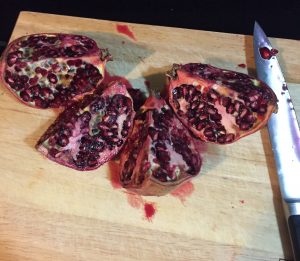
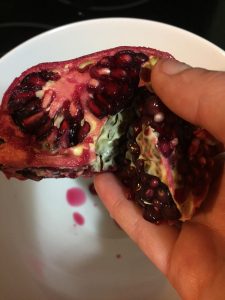
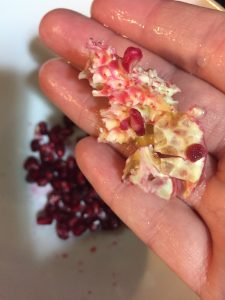
Some methods call for placing the pomegranate into a bowl of water, but I have not found this to be successful. I tend to get water everywhere, and I’ve found that some membranes sink while some seeds float.
Using pomegranates: It’s important to remember that pomegranates add a textural element to what you’re making. The joy of eating them is the spurt of juice you get from biting into a seed. (The downside of eating them is the crunch of the seed itself, which is edible but which tends to get stuck in one’s teeth, and which is why they really don’t work with vanilla ice cream.) Pomegranates have a sour, slightly grassy taste, and you don’t need a lot of seeds per serving. Remember that, because they spurt, hot pomegranate seeds will spurt hot juice that can burn the inside of your mouth. For this reason, you should add them at the end of cooking, as a garnish. They go very well with lamb, yogurt, salads, and roasted vegetables.
Persimmon
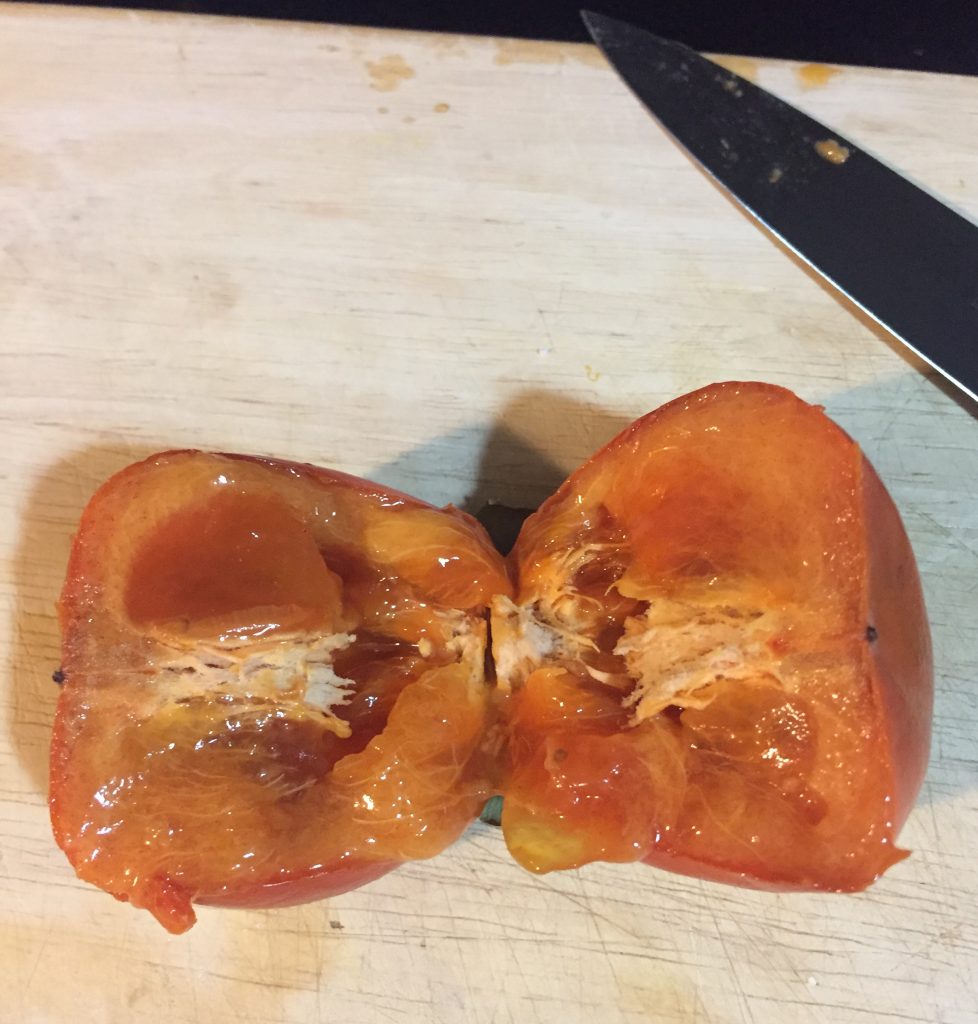
The first time I bit into a persimmon, I regretted it for the next hour. My mouth puckered up and I thought I had prompted an allergic reaction. Turns out, this is normal for an unripe persimmon. I decided to try again for this post, armed with a little more knowledge and a lot more caution.
Buying persimmons: Persimmons come in two varieties, and one of these two is extremely astringent (guess which one I had purchased the first time around?). The astringent type is the Hachiya and the other type is the Fuyu. If your grocery store doesn’t label them, look for a persimmon that is already developing brown spots. These are riper and will be less astringent in any case.
Preparing persimmons: Allow the persimmon to ripen beyond where you think is reasonable, especially if you have a Hachiya. I let mine sit on the counter until it was deflated in certain spots like an overripe tomato. I was certain I had allowed it to rot, but when I sliced it open I found it to be delicious. (After further research, I also discovered that I had a Fuyu persimmon that probably would have tasted fine if I had eaten it sooner. But better safe than sorry.)
When you do slice into the persimmon, it’s similar to a tomato. You should discard any seeds as well as the green top. I also avoided the white membrane inside, though I didn’t have any problems with the taste of this membrane when some of it still wound up on my spoon. If you have a Fuyu persimmon, you can eat the skin along with the flesh. If you have a Hachiya persimmon, the skin might still hold some astringency so you should proceed with caution.
Using persimmons: My husband talks of scooping the flesh from persimmons when he was younger and eating them like custard, so this is where I began. I found that the fruit was sweet and tasted like the stir-in fruit that comes with flavored yogurt (only better). I would definitely add it to yogurt, ice cream, toast, and even poultry. It would taste great with cheese. Because it is high in pectin, it also makes a good natural substitution for jam, without the added cane sugar. I’ve seen several online recipes for persimmon jam, but this sounds as if it would require an expensive number of persimmons. For the moment, I’ll probably use them one at a time.
Quince
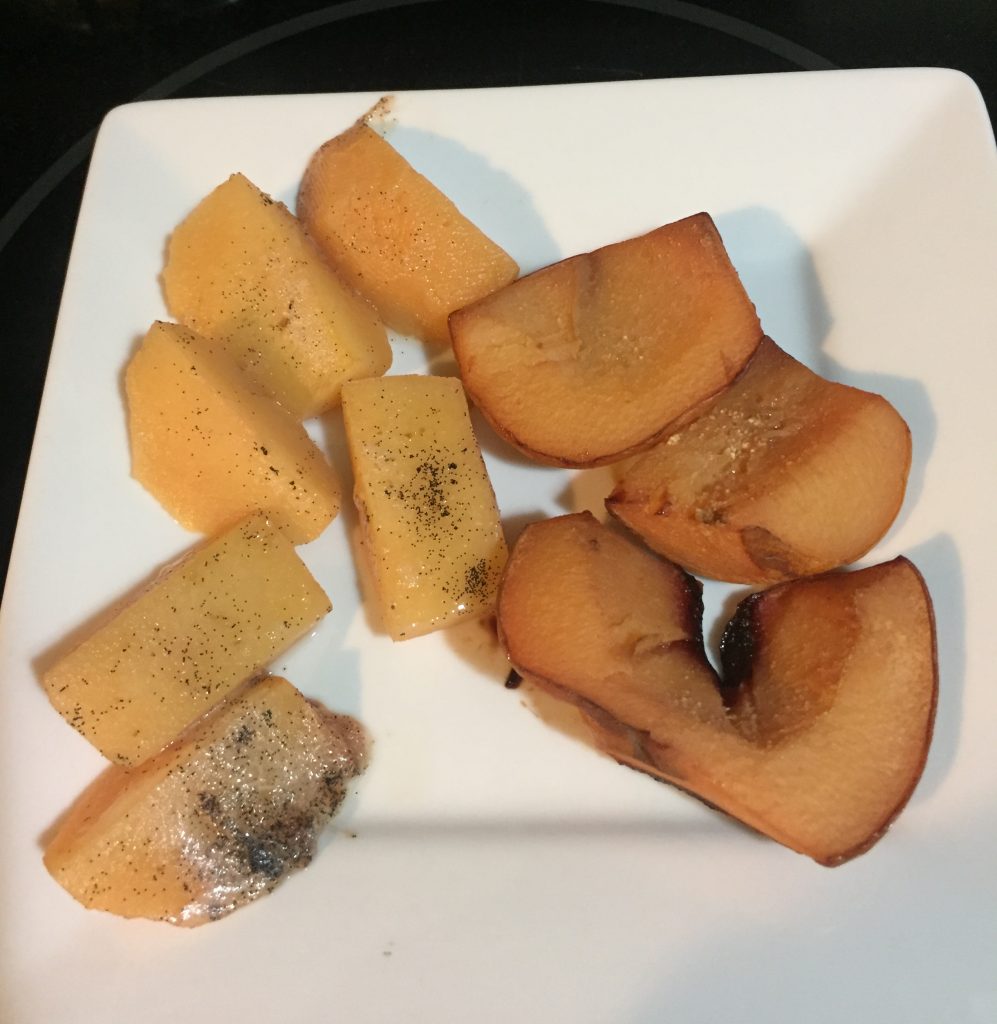
Quinces come into season in late fall and look like small, misshapen pears. I had seen them used in various of my cookbooks, particularly those with Middle Eastern recipes, so I bought two and decided to experiment.
Quinces are supposed to be highly astringent when raw and need to be cooked until tender. (After the persimmon, I needed no convincing, so I didn’t taste the raw fruit.) Once cooked, they are tart and sour, like a Granny Smith apple. Because quince is so sour, most recipes call for large quantities of sugar, but if you’re watching your sugar intake for health reasons, this presents a problem. I tried prepping my quinces two ways: poached (above left) and roasted (right). In both cases, I added freshly-squeezed lemon juice and honey, but orange juice might have been a better choice since I didn’t add additional sugar and the lemon may have increased the sourness.
Buying quinces: Look for firm fruit with no bruising. Browning on the skin is okay, but you don’t want any soft areas.
Peeling quinces: The skin contains several nutrients, but once the flesh softens the skin will seem tough by comparison, like the skin of a baked apple. I left the skin on for the roasted quince and peeled it for the poached quince. I found that both were equally edible, so you should make a decision to peel (or not) based upon your preferred texture. Note that quince browns rapidly, even faster than an apple. I didn’t find that this presented any problems once mine were cooked.
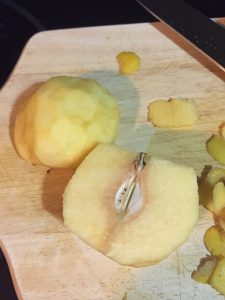
Coring quinces: You will need to remove the seeds before cooking. Unfortunately, the quince is much tougher and woodier than an apple or pear, so you will have a difficult time coring the quince without also slicing up the fruit. Use a sharp knife that you can control well. I cut my quinces in half and then attempted to remove the seeds. I found that I could not scoop out the seeds easily with a knife (see first picture, below), and I had much better luck slicing around the core (second photo).
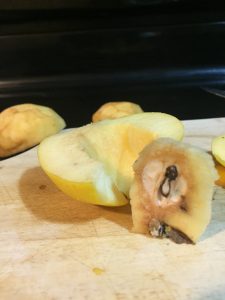
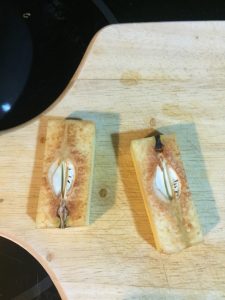
Roasting quinces: For the roasted quince, I placed the cored fruit in a baking pan, drizzled lemon juice over the top, and squeezed a small amount of honey onto each piece of quince. I didn’t want the sugars to burn, so I covered the pan with wax paper to trap any steam. I then left the quince to bake at 300ºF for the better part of an hour. Quince turns slightly pink when cooked, so it’s easy to tell when it’s done.
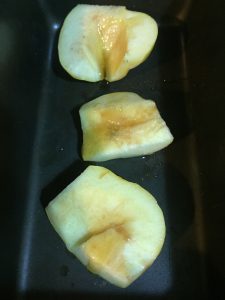
Poaching quinces: Here I tossed the sliced quince into a small pan along with the juice of 1/2 lemon and about a tablespoon of honey. I also scraped the seeds from 1 1/4 inches of vanilla pod and filled the pan with enough water to cover the quince. I cooked the quince over medium heat for about 30–40 minutes but then realized that I needed to add more water. Next time I would either experiment with covering the pan or with adding double the water. My poached quince was less pink than my roasted quince, but it was more tender, in spite of having cooked for slightly longer. This could be due to the fact that I had removed the skin. Vanilla is supposed to be a flavor that pairs extremely well with quince, but I didn’t feel that it added a lot of flavor without extra sugar, so don’t worry if you haven’t any fresh vanilla.
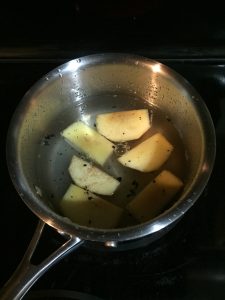
Using quinces: After tasting the quince on its own, I determined that it would, in fact, make a fine addition to apple pie. It would also taste great with pork or another rich meat such as lamb (or maybe duck?) as a way of cutting the umami flavor. When I researched online, I found several sources recommending that quince be stirred into yogurt or that the remaining poaching liquid be used as a kind of syrup. I suspect that this would be true if I had used sugar, but since I didn’t, I would probably stick to savory applications unless I were making a dessert.
Want to see a particular ingredient profiled in a future post? Look me up on Twitter (@ditchtheramen) and let me know! Until then, happy holidays and happy cooking.


